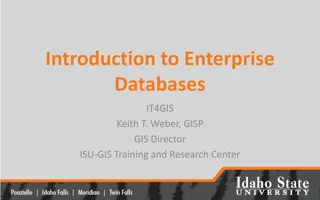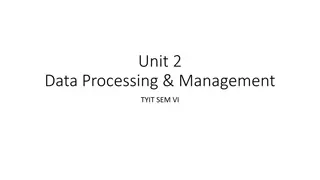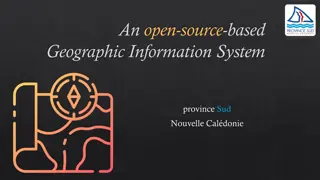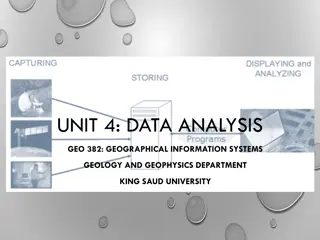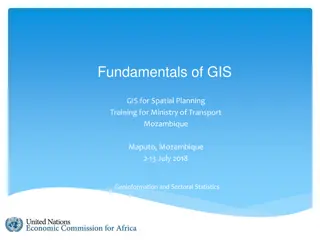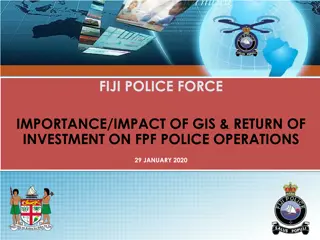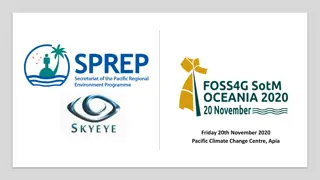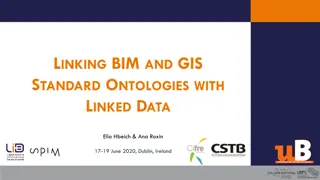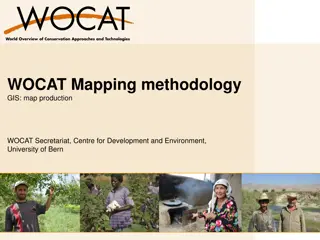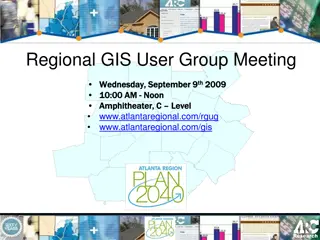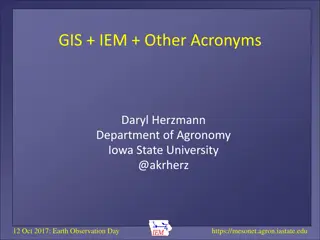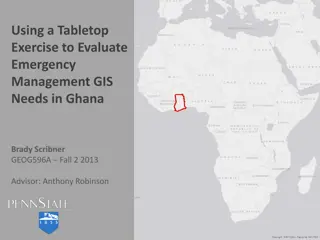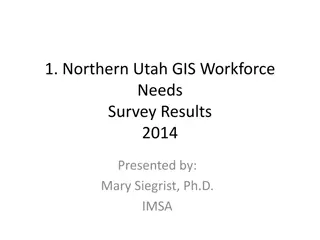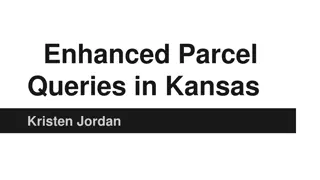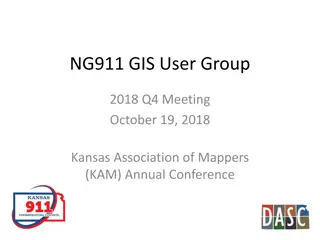Understanding GIS Data Collection and Sources
Exploring various data sources for GIS projects, this information discusses the importance of data collection, different types of data (primary, secondary, administrative records), formats (digital, hardcopy), and the value of spatial data. Emphasizing the significance of in-house data and major GIS data sources like maps, aerial photographs, and government databases, it underlines the necessity of pre-processing and conversion in GIS projects.
Download Presentation

Please find below an Image/Link to download the presentation.
The content on the website is provided AS IS for your information and personal use only. It may not be sold, licensed, or shared on other websites without obtaining consent from the author. Download presentation by click this link. If you encounter any issues during the download, it is possible that the publisher has removed the file from their server.
E N D
Presentation Transcript
Data Sources and Conversion Feeding the GIS Dr. Ahmad Bin Touq abintouq@uaeu.ac.ae http://faculty.uaeu.ac.ae/~abintouq GEO 440: GIS for Urban & Regional Planning
Data Sources and Conversion Feeding the GIS Discussion here focuses more on projects than organization-wide implementation. Like a teenager, a GIS can consume more than data you ever imagined! Often, data collection is an end in itself. Almost invariably, it s the costliest element of any project-- > 80%.
Data Sources and Conversion Feeding the GIS. Discussion here focuses more on projects than organization-wide implementation. Like a teenager, a GIS can consume more than data you ever imagined! Often, data collection is an end in itself. Almost invariably, it s the costliest element of any project-- > 80%.
Where do I get data? & What form is it in? Where? Secondary: existing data already published/available special tabulation/contract Administrative records: data as by-product within your organization other organizations Primary data: from scratch developed in-house (DIY) contracted out (field work is always slow and expensive!) What format? machine readable (digital) hardcopy (paper, maps) Applicability & suitability generally decrease. Time & Cost Increase Spatial data in digital form is the most valuable since this is generally the most expensive to obtain.
Dont forget to look in-house! collected by your organization as data by-product of normal agency operations acquired for some other project Don t forget to look, especially if it s a large organization. There may already be a GIS project in existense or about to be launched!
Major GIS Data Sources Maps Drawings (sketch or engineering) Aerial (or other) Photographs Satellite Imagery CAD data bases Government & commercial spatial (GIS) data bases Government & commercial attribute data bases Paper records and documents
Pre-processing and Conversion: almost invariably required! GIS Data Bases conversion between proprietary standards (ARC/INFO, Intergraph, AutoCAD, etc.) Spatial Data Transfer Standard Attribute Databases geocoding if micro data conversion between geographic units (e.g. zip codes and census tracts) conversion between different databases Records and Documents OCR (optical character recognition) scanning keyboarding then, same as attribute data bases Maps and Drawings digitizing, or scanning than raster to vector conversion Aerial Photographs photogrammetry/photo interpretation to extract features digitizing or scanning to convert to digital rectification and DTM (digital terrain model) to create digital orthos Satellite Imagery rectification and DTM to create digital orthos (if desired) CAD Data Bases translator software (pre-existing or custom- written) needed to convert to required GIS format
Data Conversions: general comments Paper Maps to Digital generally the most complex & expensive automated extraction of layers problematic and error prone requires scanning then raster to vector conversion digitizing may be freehand with tablet, or heads-up on screen
Data Conversions: general comments Digital to Digital Conversions Safe Software s Feature Manipulation Engine (FME) product provides translation between different vendor s GIS formats spreadsheet software (Excel) is a powerful beginning point for converting to required database format (e.g. to .dbf for ArcView) specialized conversion packages for converting between different databases also available e.g. DBMS/Copy Plus, Data Junction efforts at standardization, which reduces need for conversions, have had limited success cos of competitive pressures FGDC s, Spatial Data Transfer Standard (SDTS), is a federal standard Open GIS Consortium, a vendor and user group, lobbies for standards and non-proprietary approaches to GIS database creation
Data Conversion: hints on the process NEVER CONVERT ON THE ORIGINAL FILE ALWAYS A COPY. ALWAYS convert in an unrelated sub-directory Document each new file that is made in the conversion process. Archive the original files on a readily available media Automate as many processes as possible Projections Many like files Replication of data for output Record all your steps while converting data formats, in a journal or notebook. You WILL use that same conversion sometime in the future
Data Sources: Table of Contents Overview Federal Data Sources: Spatial Data Federal & Non-profit Data Sources: Attribute data Private Sector Data Resources:Spatial and Attribute Selected Sources in Detail DIME TIGER USGS: Overview DEM detail DLG Detail DOQs and DLGs Digital Chart of the World NAVSTAR: gps Remote Sensing US Census Bureau Attribute Data Primary Data Collection: Some Issues As of Fall, 1999, single best web index to available data is: http://cast.uark.edu/local/hunt/index.ht ml
Federal Data Sources: Spatial Data Federal Data Agencies: USGS (Geological Survey, National Mapping Div.--Interior) all kinds of mapping, not just geology! NGS (National Geodetic Service-- Commerce, part of NOAA) geodetic surveying [Ordnance Survey (in U.K.) combines both functions.] Federal Mission Agencies USDA (Agriculture) Resource Conservation Service (formerly Soil Conservation Service) US Forestry Service DoD (Defense) National Imagery and Mapping Agency (NIMA) originally Defense Mapping Agency (DMA) US and world terrain mappings NAVSTAR: gps satellites US Army Corp. of Eng.: flood control Interior US Fish and Wildlife: wetlands Bureau of Land Management NASA (National Aeronautics and Space Administration LANDSAT satellites Commerce Census Bureau: DIME & TIGER files NOAA (National Oceanic and Atmospheric Administration) AVHRR (Advanced Very High Resolution Radiometer) weather satellites
Federal & Non-profit Data Sources: Attribute data Federal Data Agencies CB (Census Bureau-- Dept of Commerce) population and industry data from surveys BEA (Bureau of Economic Analysis-- Dept. of Commerce) STAT-US: national accounts Federal Mission Agencies Most federal agencies now have a stat. dept Bureau of Labor Statistics National Center for Health Statistics National Center for Education Statistics National Center for Criminal Justice Statistics National Center for Transportation Statistics Interstate Commerce Commission Internal Revenue Service Non-profit interest groups: Urban and Regional Information Systems Association (URISA) National League of Cities Population Reference Bureau Transportation Assoc. of America Trade Associations: American Public Transit Assoc. see Encyclopedia of Associations Trade Publications Progressive Grocer see Business Periodicals Index University Research Centers University of Michigan, National Institute for Social Research
Private Sector Data Resources Attribute Data Wide array of companies and services. pollsters and market surveyers remarketeers/updaters of federal gov. data (census data, TIGER files, etc..) data aggregators: collect admin. data from state and local gov. (e.g. building permits) gap fillers in government offerings Larger providers include: Claritas/National Planning Data Corporation Equifax/National Decision Systems Blackburn/Urban Decision Systems SMI/Donnelly Marketing Specialized providers include: Dun and Bradstreet (firms) TRW-REDI (property data) Spatial data GIS software vendors e.g. ArcData Catalog Satellite Data Sellers SPOT (French satellite) EOSAT (LANDSAT Thematic Mapper data) Topological data (street networks and boundaries) Etak DeLorme Geographic Data Technology Environmental Earthinfo Hydrosphere Aerial Surveying/ Engineers/Consultants legions of them primary data
Vector Data Implementations: DIME file (Dual Independent Map Encoding) introduced for the 1970 US Census and used again in 1980; replaced by TIGER in 1990 pioneering early example of topological structure basic record was a line segment flat file structure with all info in one record (Star and Estes misleading) segments defined between every intersection for all linear features in landscape (streets, railroads, etc) each segment record contained items such as: segment ID Segment type from node ID to node ID from node x,y to node x,y address range left address range right city left city right tract left tract right other left/right polygon ID info as needed e.g. county, block, prepared only for metroplitan areas (278 files covering about 2% of nation) some cities (very few) maintained and expanded (e.g add zoning) them after Census inconsistent with Metroplitan Map Series paper maps published for each census very compute intensive to process into continuous streets or polygons
Vector Data Implementation: TIGER File (Topologically Integrated Geographic Encoding and Referencing file) comprises 6 record types (tables) basic data record (type 1): line segment records similar to DIME file shape coordinates (type 2): extra coords to define curved line segments area codes (type 3): block records giving higher order geog (tract, city, etc) feature name index (type 4): line segment records with code for alternative names (used when a segment has two or more charateristics (e.g both Main St and US 66) feature name list (type 5): names associated with codes n Type 4 special addresses ranges (type 6): additional address ranges (e.g if zip code boundary splits a line segment Minor differences exist in layout of various versions of TIGER which can lead to reading problems introduced for 1990 Census to eliminate inconsistencies between census products cover entire country, and released by county include hydrography, roads, railroads, etc. uses relational data base model data derived from 3 sources: scanned USGS 1:100,000 Map Series addresses ranges from DIME file, originally updated to 1986/7 geographic area relationship files used by CB to process 1980 census problems with TIGER accuracy limited by USGS base map and processing (100m horizontal) one time only; many segments missing. many local gov. records better data only: requires software to process. First version was Tiger/1992 Latest is TIGER/Line 1998, issued July, 1999
Vector/Raster Data Implementation: USGS (United States Geological Survey Digital Data) Digital Elevation Model (DEM) data: Raster elevation data available at 30m, 2 arc second, and 3 arc second spacing (1 sec. of lat ~100ft) Digital Line Graph Data (DLG) data digital representations of the cartographic line info. on main USGS map series. Vector planimetric data provided in full node/arc/polygon format Land Use and Land Cover (LULC) data Land use and land cover data from 1:100,000 and 1:250,000 sheets Available in both raster format (4 hetare [10 acre] cells) and vector polygon format Geographic Name Information System (GNIS) Data standardised place names and feature classification Digital Orthoquads and Digital Raster Graphs raster data related to USGS 7.5 minute quads Distibution of digital data by USGS began in the early 1980s. For details see: USGS National Mapping Program USGS Digital Cartographic Data Standards, Washington, D.C.: Geological Survey Circular 895A thru G, 1983.
USGS: DEM Data Detail (Digital Elevation Model) Each file has three records: Record A: descriptive information Record B: elevation data Record C: accuracy statistics Files classified into one of three levels depending on editing, etc Level 1: raw elevation data; only gross blunders corrected. Level 2: data edited and smoothed for consistency. Level 3: data modified for consistency with planimetric data such as hydrography and trans. Raster elevation data. 7.5 minute, 1:24,000 USGS quads (15 minutes in Alaska) elevations at 30 meter spacing UTM coords, NAD27 datum accuarcy: <15m RMSE (some <7) (horizontal: 15m) 30 minute, 1:100,000 USGS topo sheet 2 arc second spacing NAD27 datum accuracy: 5-25m--1/2 map contour int. (horizontal: 50m) 1 by 2 degree, 1:250,000 USGS sheets from Defense Mapping Agency (DMA) 3 arc second spacing WGS72 datum variable: 30-75m (horizontal: 100m)
USGS DLG Data Detail (Digital Line Graph) Coverages (up to 9) Hydrography: all flowing and standing water, and wetlands Hypsography: contours and elevation Transportation: roads, trails, railroads, pipelines, transmission lines Boundaries: political & administrative Public Land Survey System (PLSS): township, range, section (not ss) Vegetative surfaces (ls only) Non-veg surfaces (e.g. sand) (ls) survey control and markers (ls) manmade features (e.g. buildings)(ls) Horizontal Accuracy: large scale (7.5min.): 12-50m medium (1:100,000): 50m small : ?? Three products: Large Scale (ls) -- generally 1:24,000 7.5 minutes per file Medium Scale (ms) -- 1:100,000 30x30 minute files (half a map sheet) Small Scale (ss) --1:2,000,000 21 files for nation (one CD-ROM) Three formats: Standard (no longer available) internal cartesian coords (saves storage) limited topological info; Optional (DLG-3) (use for GIS): UTM metric (Albers Equal Area Polyconic for small scale) full topological info Graphic (small scale only) GS-CAM compatible; no topological info. OK for display
USGS New Products DOQs and DRGs Digital Ortho Quads(still in progress--depends on state/local cooperation) Digital image of an aerial photo in which displacement caused by camera lens, airplane s position, and the terrain have been removed-- image characteristics of a photo and geometric properties of a map. 1:12,000 scale; UTM coords, NAD83 datum 1 meter resolution; 33 feet (10m) positional accuracy (national map stand.) associated DEM (digital elevation model) 7m vertical accuracy quarter quadrangle coverage: 3.75 by 3.75 minutes use as base for topo and planimetric maps (if accuracy is sufficient) Digital Raster Graphics Scanned image of USGS topo map, recast in some cases to UTM. 1:24,000/7.5 quads current; 1:100,000 & 1:250,000 future 250dpi; 8-bit color; TIFF file; 64 per CD-ROM use as backdrop/validation for other digital data
Digital Chart of the World spatial data base of the world.; 1st released cerca 1992 1:1 million target mapping scale US DoD project in coop. with Canada, Australia, and UK 1.7GB of data on 4 CD-ROMs (North America, Europe/Northern Asia, South America/Africa/Antarctica, SouthernAsia/Australia). $200 cost derived from DMA's 1:1 million scale Operational Navigational Chart (ONC) base maps in Vector Product Format (VPF), but also available in most GIS vendor formats, and ASCII The VPFVIEW 1.1 freeware for DOS and SUN OS available to view VPF World Geodetic System 84 datum Airports, boundaries, coastal, contours, elevation, geographic names, international boundaries, land cover, ports, railroads, roads, surface and manmade features, topography, transmission lines, waterway 1,000 ft contours with 250ft supplements 17 layers with 31 feature classes * Aeronautical Information * Cultural * Landmarks * Data Quality * Drainage * Supplemental Drainage * Utilities * Vegetation * Supplemental Hypsography * Land Cover * Ocean Features * Physiography * Political * Populated Places * Railroads * Roads * Transportation Structures worldwide index with 100,000 place name
NAVSTAR Global Positioning System (gps) NAVSTAR Satellite Program 25 (NAVigation Satellite Time and Ranging) satellites in 11,00 mile orbit provide 24 hour coverage worldwide first launched 1978; full system operational December 1993. gps receiver computes locations/elevations via signals from 3-5 simultaneously visible satellites Selective Availability (SA) security system 100m accuracy with single receiver, if active 10-15m accuracy if inactive mutiple receivers &/or correction info. (from multiple sources) counteract SA to be turned off in year 2000 USCG broadcasts correction signal! Russia s 21-satellite GLONASS (Global Navigation Satellite System) also available. Types of Ground Collection kinematic: high accuracy engineering (within cms); two receivers (base station and rover must lock-on to satellites equipment $18-35K per station differential surveying accuarcy (1-5m) no lock required equipment $1,500-$15,000 per receiver correct for SA and other errors via real time correction signal post process with data from Internet connect to laptop PC for direct data input and entry of attribute info. use to collect ground control for digital orthos, or for point/line data collection (manholes, roads, etc) cost now $10-25 per point ( $100 a few years ago) autonomous (navigational/recreational) 100m accuracy generally (10m without SA) single, hand-held unit $150-$1,500 per unit
plots of positions collected by Garmin 38 GPS receiver at same location on three successive occasions 38 36 34 Latitude (secs. from N 32 56 ) 32 30 11 13 15 17 19 21 23 approximately 200 points per plot. 38 36 34 one point collected per 2 seconds. 32 30 11 13 15 17 19 21 23 1 second of latitude approx. 30m 38 (satellite view restricted) 36 1 second of longitude approx. 25m 34 32 30 (location: 524 Highland Blvd, Richardson, TX) 11 13 15 17 19 21 23 Longitude (secs. from 96 43 ) 23
Series 1 seconds 17.569 15.778 18.477 2.699 67.475 Series 2 seconds 16.451 14.817 17.938 3.121 78.025 Series 3* seconds 18.166 11.697 22.197 10.5 262.5 Longitude 96 43' Average Min Max range (seconds) range (meters) seconds 36.416 34.979 37.199 2.22 66.6 seconds 36.657 34.559 38.159 3.6 90 seconds 36.039 30.359 38.759 8.4 252 Latitude 32 56' Average Min Max range (seconds) range (meters) meters 150.249 120 192 meters 196.439 171 223 meters 295.708 215 314 Elevation Average Min Max range (seconds) range (meters) 72 52 99 1 second of latitude is approx. 30 meters. 1 second of longitude (@32N) is 25 meters. * satellite view restricted
Factors Affecting GPS Accuracy ionosphere worst in evening at low altitudes (but ephemerous best there) troposhere especially water vapor which slows signal multipath reflected signals from buildings, cliffs, etc ephemerous position and number of satellites in sky 4 required for 3D (horiz. and vertical), 3 for 2D (no elevation) ideallly, 3 every 120 horizon. with 20 elev., 1 directly above blockage (of satellite signal) by foliage, buildings, cliffs, etc.
GPS Receiver Characteristics Irrespective of cost ($150 to $50,000) all have same accuracy in autonomous mode! processing speed & channel capacity (# of satellite data streams simultaneously processed) storage capability: internal & PCM/CIA cards codes it can process (L1, L2; code, carrier phase, etc.) antenna type and remote connection support interface capabilities RTCM: standard for input of differential correction signal NMEA (National Marine Electronics Association):positions for real-time interface to instruments (also to PC software e.g. for location on a map) RINEX (receiver independent exchange): output of raw satellite data for post processing other proprietary: for waypoints, routes, position data, etc. upload/ download specialized user support features (hiking, marine nav., surveying, civil eng., etc.)
Remote Sensing remote sensing: info. via systems not in direct contact with objects of interest: via cameras recording on film, which may then be scanned (primarily aerial photos) via sensors, which directly output digital data (primarily satellites, but also planes) image processing: manipulating data derived via remote sensing photographic film types: monochrome (black and white) natural color infra-red (insensitive to blue, but goes past visible red; good for geology, veg. , heat) types of sensors passive (most common): record natural electromagnetic energy emissions from surface active (radar): record reflected value of a transmitted signal (e.g. Canada s RADARSAT, NASA s SIR-C/X-SAR) penetrate clouds; also, some ground penetration possible. passive sensors: typically store one byte of info (256 values) per spectral band (a selected wavelength interval in the electromagnetic spectrum); panchromatic: single band recorded (e.g. SPOT Panchromatic) multi-spectral: multiple bands recorded (e.g. LANDSAT MMS-4, TM-6) hyperspectral: hundreds of bands (TRW s proposed Lewis satellite has 384) spectral signature: the set of values for each band typifying a particular phenomena (e.g. blighted corn, concrete highway) to allow unique identification
Current Satellites Satellite Name LORAN-C ARGOS NIMBUS-AVHRR 1978 TRANSIT/Doppler NAVSTAR (1993- SPOT Panchromatic (1986- SPOT Multispectral (1986- LANDSAT (1982-) Thematic Mapper (TM) LANDSAT (1972-) Multi-Spectral (MSS) LANDSAT (1994- Enhanced TM Next generation (1997?) Main Purpose Navigation Wildlife tracking Weather predecessor to GPS global positioning remote sensing single band (visible) remote sensing 3-bands (inc. infra-red) remote sensing 6-bands remote sensing 4-bands remote sensing Accuracy 250 m 500m 1000m Resolution 1km 100m to 1cm 10-25m 10m 20-50 20 30-70 30 70-150 80 (1:100,000) 15 (1:50,000) 1 15-50 remote sensing Source: Keating, BLM Tech. Note # 389, 1993
Next-Generation Satellites (selected) expected to generate at least 750 GB of data per day-- Beam me down, Scotty! Company/Organization EarthWatch Satellite EarlyBird Bands Resolution Launch Re-visit 2-3 1 3 1 4 1 4 3 15 0.82 3.28 1 4 30 3 15 1.5 10 20 5 10 15 30 60 10 20 30 1Q97 QuickBird 1998 2-3 resolution in meters; revisits in days Space Imaging/EOSAT Carterra 1 4Q97 4 TRW Lewis Clark 384 1 2 1 1 3 1 4 1 6 infrared 1 4 radar 1Q97 2Q97 7 4-7 Core Software/Israel Aircraft Spot (France) 4Q97 1998 Spot 4 Spot 5A 1999 NASA (Enhanced Thematic Mapper) Landsat 7 (ETM) 4Q98 16 Indian Gov. IRS-1D 1999 European Space Agency (ESA) Resolution of new satellites makes urban mangement applications possible. ENVISAT 1998 Source: Carlson and Patel, GIS World, March 1997 ASPRS Land Satellite Information for the Next Decade, conference proceedings, Sept 1995
Some Notes on New Satellites (early 1997) Satellites vary by: orbit, altitude, revist variability (steering) capability, width of swath, image size, stereo capability, wavelengths collected, other sensors, etc. EarthWatch: WorldView Imaging Corp and Ball Aerospace with Hitachi (Japan), Nuova Telespazio (Italy),MacDonald Dettwiler (Canada), CTA Space Systems (Rockville, MD), Datron (Escondido, CA) Space Imaging/EOSAT: Lockheed Martin, Raytheon/E-Systems,Mitsubishi, Kodak. Purchase of EOSAT (Earth Observation Satellite Company) in 11/96 and formation of a Mapping Alliance Program with 10 big-time aerial mapping companies [e.g Woolpert (Dayton), Analytical Surveys, Inc (Colorado Springs)], makes them a powerhouse for data. TRW: part of NASA s Small Spacecraft Technology Initiative, with satellite built by CTA the Global Change research project s Earth Observation System (EOS), which includes NASA s Mission to Planet Earth, includes a wide variety of monitors & sensors on multiple satellites from different countries through 2008 Countries with existing/planned satellites include: Argentine, Brazil, Canada, France, Germany, India, Israel, Japan, Korea (South), Ukraine, US.
The Relative Cost of Different Options (as of 1993) Source: Keating, BLM Tech. Note # 389, 1993 least expensive Satellite Remote Sensing 1cent Photogrametry Maps and Existing Digital data $100 Global Positioning System Survey $1,000 1cm 1m 30m least accurate 31
U.S. Census Bureau: Attribute Data (see: Census Catalog and Guide published annually) Data Collection Methodologies Census mandatory, entire population regular but infrequent, as benchmark Update surveys not mandatory, update censuses limited geog detail, usually annual (some weekly) Special Surveys not mandatory; cover data not in census often on contract with other agency (e.g National Health Survey) Non-Survey admin records from other agencies update census (e.g. Current Poplation Reports) provide additional info (e.g. County Business Patterns) Census of Population and Housing 10 year cycle (1990) two main tabulations Full count (STF1 & 2) geog. detail down to block Sample (STF3 & 4) 20% stratified sample long form attribute detail Economic Census 5 year cycle (1993) agriculture, retail, manufacturing, service, transportation, government, construction
Aggregation Issues in Attribute Data Aggregate data groups of individuals or entities by geographic area--block, tract by time: rainfall/sales by day, month, year by characteristic: age group, race, species polygons required for mapping Cross-sectional: different spatial units at one point in time Longitudinal: one spatial unit at different points in time Dynamic: continuously produced over time and space (some satellites; CORS program) Disaggregate (micro) data individuals or individual entities persons, households, firms, parcels, housing units, establishments trees, poles, wells geocoding required confidentiality/disclosure a critical issue suppresion may be imposed on aggregate data
Samples, Populations and Spatial Patterns Some Issues for Primary Data Collection random clustered dispersed Population: --all instances of a phenomena Sample: subset of population random: each pop. member has equal chance of being chosen systematic: members chosen based on repetitive rule (every 10th; every 4 feet) stratified:; sampling conducted within groups to ensure representation Especially tricky for spatial data! equal high low Probability of one point being close to another Spatial sampling methods point: collect info at one spot transect: along a line quadrat: within a square 34
Summary of Data Collection Issues Suitability/Appropriateness for the Task horizontal (and vertical) accuracy: 33 feet USGS DOQ, versus 3 feet for urban needs documentation often bad for administrative records currency and frequency of update is date and/or update cycle appropriate? completeness is undercount/omission a serious problem? e.g. most lists miss the poor (census undercounts); TIGER file once per decade aggregation and sampling are they appropriate? cost -- highly associated with accuracy is cost within budget? is benefit greater than cost?





